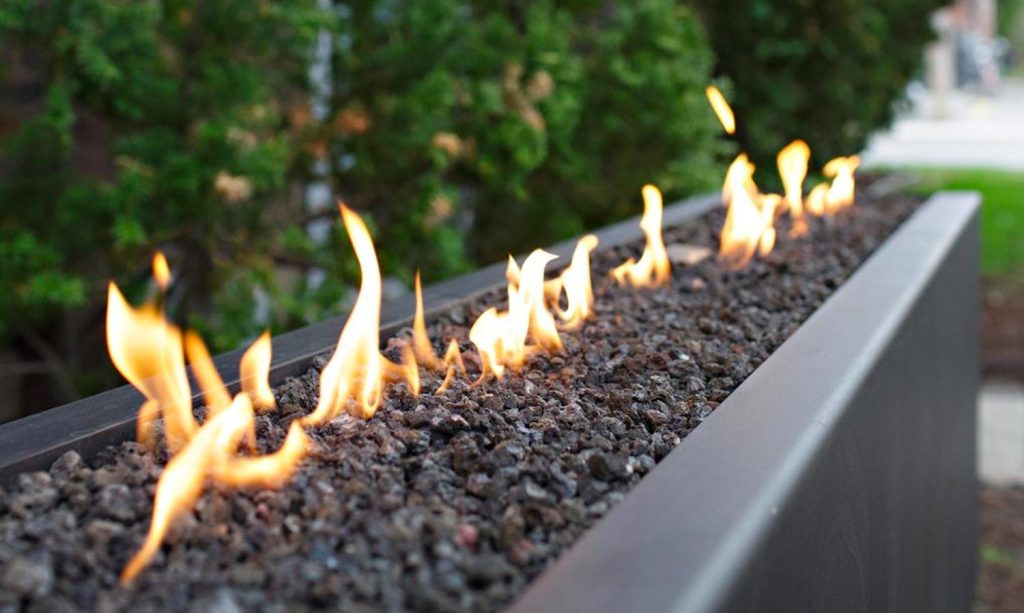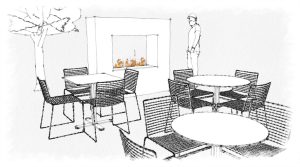When planning an outdoor fire pit, one of the main decisions that you will have to make is the type of ignition system you want – in other words: how do you want to light it? Paloform offers two types of ignition: electronic and manual. Each has its advantages, safety features, and installation requirements.

ELECTRONIC IGNITION – ELEGANT AND CONVENIENT
Electronic Ignition, as the name implies, uses electricity to light a fire. Operation is very simple: when power is turned on, the fire pit lights, and when the power is turned off, it extinguishes.
The “brain” of the electronic ignition system is a computerized control board: When power is sent to the board, it begins a spark sequence that ignites a small pilot burner. The pilot flame activates an electronic flame sensor which sends a signal to the control board to turn on the main burner. While the main burner is on, the flame sensor continually monitors the fire to ensure that it does not go out and create a dangerous situation where unburnt gas is allowed to escape into the air. If the fire does go out, it will automatically relight, and in the unlikely situation where it cannot relight, the fire pit will shut down.
Paloform’s electronic ignition burners are designed to be simple to install, control and service. They require a standard line voltage receptacle installed inside the fire pit vessel, in addition to a gas line. Connecting the burner to power is as easy as plugging it in.
Using line voltage (a standard household power outlet) to control the fire pit has some distinct advantages over low voltage or battery power:
- Flexibility in controls – the fire pit can be controlled by any system that can turn a power outlet on and off. This can be as basic as a wall switch or as complex as a “smart” home control system.
- Seamless design – there are no external control panels, knobs, or switches on the fire pit itself. There are also no batteries to replace and accordingly, no battery compartments to access.
- Standard fittings and voltage – the electrical connection requires an off-the-shelf outdoor receptacle – no specialized fittings are needed – and requires a standard household voltage.
If you have the option of bringing power to your fire pit location, then electronic ignition offers convenience and control flexibility. If not, then manual ignition will be the choice for you.

MANUAL IGNITION – SIMPLICITY AND SAFETY
Manual ignition is often referred to as “match-lit” as you must light the flame using a barbecue lighter or match. Most match-lit fire pits on the market require you to hold a flame to the burner while turning on the gas with a simple on/off valve. While this type of system is widely recognized as safe and can be certified (up to 65,000 BTU/h in North America), lighting one can be a slightly harrowing experience for the uninitiated in that you are lighting a potentially large volume of gas.
Paloform’s manual ignition system utilizes a pilot to make the experience of lighting your fire pit less “exciting.” Instead of holding a flame to the main burner, you need only light a small pilot burner, about the size of a candle flame. Once the pilot flame is established, you activate the main burner by turning a key. Like our electronic burners, Paloform’s manual systems include flame monitoring and will shut off the gas if the fire ever goes out due to a sudden gust of wind or torrential downpour.
Manual ignition fire pits require only a gas or propane line – no electrical connection – so they offer the flexibility of being installed in a wider range of sites than their electronic counterparts. If run off bottled propane, they can even be used in off-grid sites. The downside of manual fire pits is that they are more difficult and take longer to light than electronic ones.
Whichever ignition style you choose, you can be assured that each is certified to the latest safety standards and has a flame-monitoring system designed to eliminate the possibility of unwanted and potentially dangerous gas.



